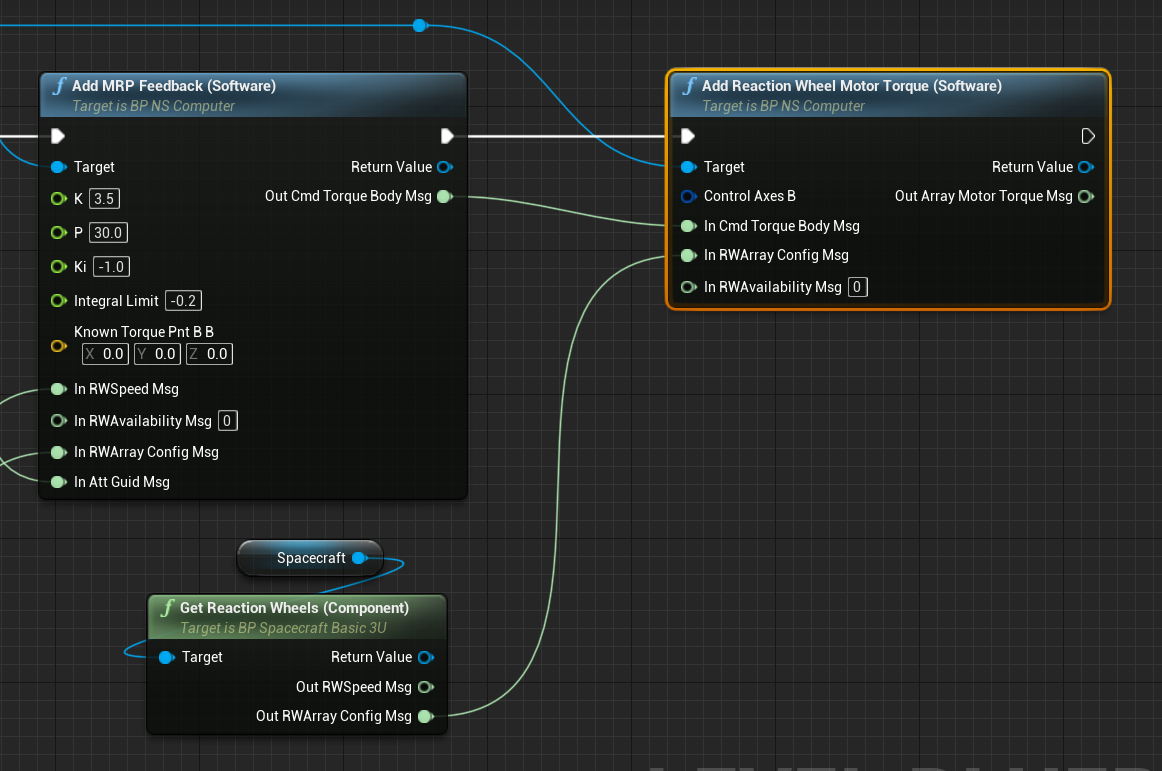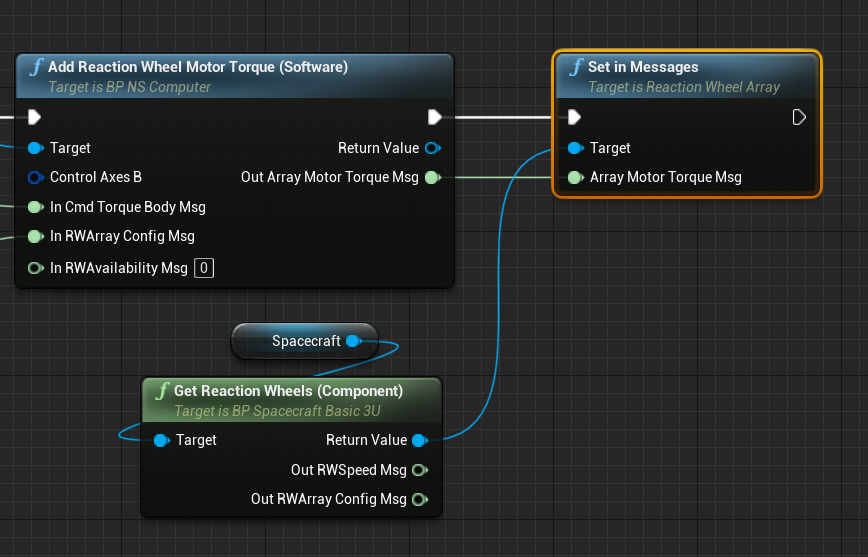Editor: Inertial Hold Pointing Chain
Description
This guide showcases how to create an inertial hold-pointing chain on a spacecraft. This chain is designed to direct the orientation of a spacecraft towards a specific inertial frame. This is useful for having an abstract orientation of the spacecraft that is desired, with the frame being adjusted during the simulation.

This example scenario can be found at the Dynamics/Demo_AttitudeFeedbackBasic level. It uses an external force torque (although this example explains how the reaction wheels can be configured) to orient the spacecraft's attitude to align with a reference frame.
Creating the Spacecraft
Start by configuring a level with a spacecraft spawned in orbit. The spacecraft must have the following components for this chain to work:
- Reaction Wheels
- Computer
The spacecraft can have any other number of components and instead of reaction wheels, an external force torque or some other software for dynamical orientations can be used. For this guide, reaction wheels will be used as the dynamic effector. The spacecraft shown is used for this guide.

Adding the Navigator
Next, after spawning the spacecraft in the level blueprint, flight software can be added to the spacecraft. This is usually done in a blueprint function but can be done directly on the Event Graph. The first step is to add the Navigator component. This is required for all flight software chains, and the inertial-pointing chain is no exception. The Navigator produces the estimated position and rotation of the spacecraft, with some noise values applied. It is a source of truth and does not simulate the data from a sensor. This component needs to be added to the Computer on the spacecraft, which can be done by first fetching the computer and constructing the Navigator.

The Navigator takes three input flags, which define how the errors are added to the module:
- Cross Translation: A flag that defines a position error depending on its velocity
- Cross Attitude: A flag that defines an attitude error depending on its attitude rate
- Use Eclipse: A flag that defines whether the sun pointing vector on the navigation attitude message depends on whether the spacecraft is in an eclipse. This flag is only useful for the sun-safe pointing chain.
Adding the Inertial Hold Software
The next software will create a reference frame relative to the body of the spacecraft. This is the Inertial Hold Software and takes in a desired reference sigma, in MRPs, \(\sigma_{R_0N}\), which is the orientation of the attitude in the inertial frame. This particular software requires no input messages but produces an attitude reference message.

The reference message produces the frame \(R\) in the body frame \(B\) coordinates. It is the orientation that the spacecraft should reach with the torque applied.
Adding the Attitude Tracking Error Software
The next module to add to the chain is the Attitude Tracking Error Software, which takes in both the current reference frame that is targeted (in the body frame) and the current spacecraft attitude message (which can be found from the navigator on the first software module added) and determines the guidance frame that would rotate the spacecraft towards the reference. It computes the frame difference and produces the output that can be fed into a PID controller module. Without the tracking error, the reference frame is not enough to determine the correct torques for a spacecraft to reach its desired attitude.

An optional parameter is the Sigma RRc, which defines the corrected reference frame parameter. By manipulating these values, it can define a fixed frame rotation to the corrected reference frame \(R_c\) from the reference frame \(R\).
Adding the MRP Feedback Software
A standard software module that is used for all pointing chains is the MRP Feedback Software. This software module takes in a desired guidance direction and compares the direction with the current orientation. It then uses a PID controller to create a torque message that will define how much torque is given to the effectors (such as a reaction wheel or external force module) to start orienting the spacecraft in the desired vector. The guidance message is a requirement as the input for the module, however, the reaction wheel messages (speed, availability and config) are optional and can be used when a reaction wheel exists. These messages provide information to the controller on the configuration and speed of each reaction wheel and can optimize the controller for specific wheels.

The MRP controller is configurable and the PID constants can be adjusted. These parameters are dependent on the state of the system and the friction models on the reaction wheels. The default constants are suggestive and work in a majority of use cases.
- K: The proportionality-gain constant (P) to the MRP errors.
- P: The rate-error constant (D) for the feedback gain.
- Ki: The integration feedback error constant (I) on rate error.
- Integral Limit: The integration limiting torque to avoid wind-up issues.
- Known Torque Point B_B: The defined additional external torque, defined in body frame coordinates, that is applied to the controller.
Adding the Reaction Wheel Motor Torque Software
The MRP controller will return an expected torque for some effector to apply on the spacecraft in the body frame. If a reaction wheel module is used, then this torque needs to be converted to a reaction wheel command, that can be sent to the reaction wheel array on the spacecraft. This is the Reaction Wheel Motor Torque Software and it takes in the state of the reaction wheels (as a configuration message) and the required torque command and produces an array motor torque message, containing a list of torques that are to be applied to a reaction wheel. By default, if no availability message is defined, the module will assume all reaction wheels that are configured are available and operable in the system.

The reaction wheel motor torque software has one additional parameter, defined as the control axes. This parameter defaults to the identity matrix but can be configured to define a non-symmetrical axis of control, in the case that a reaction wheel or software produces the torques in a rotation that is not equivalent to the reaction wheel direction vectors.
Connecting the Reaction Wheel Message
The reaction wheel motor torque software produces an array message that the reaction wheel uses to control the torques of each wheel. The final task of the flight software chain is to connect the message to the reaction wheel. This can be done using the Set In Messages method, which is the standard syntax for updating the input messages of a component.

These are all the required software modules for the inertial hold pointing chain to be implemented on a spacecraft. Additional software modules can be added for specific use cases, such as a power voltage conversion.